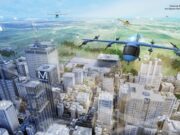
Drone flight restriction zones have been expanded around airports in the U.K. under a new rule that took effect March 13.
Under the DroneSafe program, operated by the U.K. Civil Aviation Authority (CAA) and air traffic management organization U.K. NATS, the previous ban on drone flights within 1 km (0.5 nm) of an airport boundary has been replaced by “a restriction using the airfield’s existing aerodrome traffic zone,” with a radius of either 2 nm (4 km) or 2.5 nm (5 km), “and then five km [2.7 nm] by one km zones starting from the point known as the ‘threshold’ at the end of each of the airfield’s runways,” the CAA and NATS said. Both zones extend to 2,000 ft above the airfield.
“It is illegal to fly any drone at any time within these restricted zones unless you have permission from air traffic control at the airport or, if air traffic control is not operational, from the airport itself,” the agencies said. Maps of each airport’s restriction zone are available at the NATS Aeronautical Information Service website.
Establishment of the restriction zones comes not quite three months after London’s Gatwick Airport was closed for 33 hours because of repeated sightings of drones over the airfield. Authorities estimated that at least 120,000 passengers were affected, and described the flights as part of a “deliberate and serious” attempt to disrupt traffic at the U.K.’s second-busiest airport. The operator of the drone has not been found.
A similar problem was reported around the same time at London Heathrow Airport, but flights there were halted only briefly.



